The HTC 10 Review
by Joshua Ho on September 19, 2016 8:00 AM ESTLatency with Google WALT
One of the major points of differentiation with the HTC 10 is supposed to be smoothness. This, more than anything was something that HTC emphasized repeatedly in their initial introduction of the HTC 10. This phone is supposed to be smooth in a way that most of the Android competition isn’t. It’s really kind of disappointing to me that there isn’t a lot of information in the public domain testing HTC’s claims.
So in the interest of testing this out, I managed to get a WALT device working. What's WALT, you may ask? It's an internally developed Google toolset and hardware device combination to measure touch latency on Android (and Chromebook) products. By combining some simple external sensors connected to a Teensy board with the appropriate software to measure those sensors, WALT makes it possible to directly measure several forms of touch and audio latency of an Android device. Normally this would require a high-speed camera, but Google has developed WALT as a more practical alternative, internally validatating the product against said high speed footage.
To start we can look at tap latency and screen response time. Combining these two figures together will give us the total time it takes at minimum for the device to respond to a tap. It’s worth noting here that there is an upper bound to screen response time because devices are generally locked to 60 Hz and triple buffering means that our response time at best can be 48 ms. The screen response time figure is dominated by this latency in almost all cases, with some extra overhead for the panel’s native response time and some OS overhead can be involved as well.
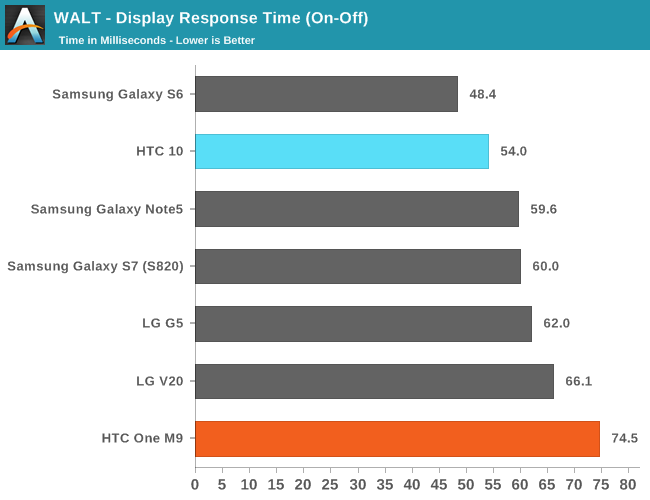
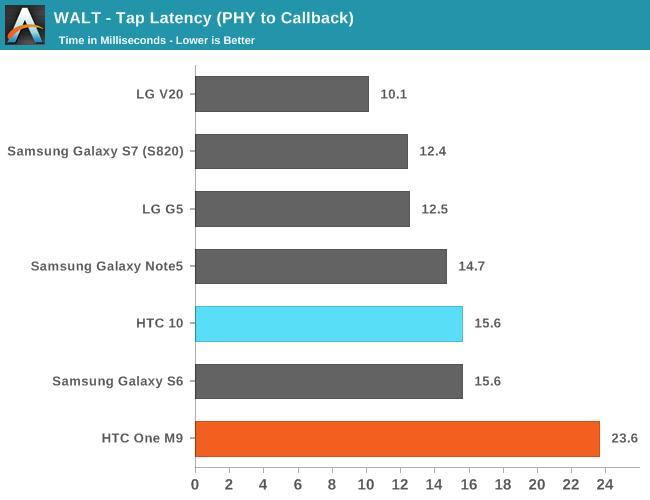
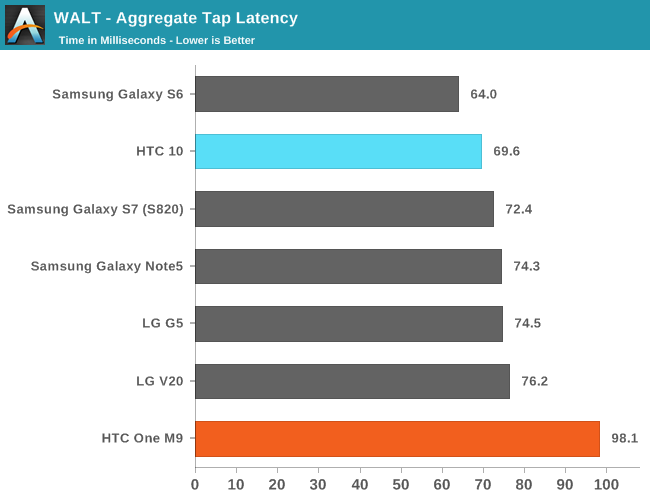
In tap latency the HTC 10 performs fairly well but everything is so close here that I'm not sure it really matters. In the interest of trying to see what exactly HTC was trying to highlight I also went ahead and used the drag latency test to try and see if this was a notable point of differentiation.
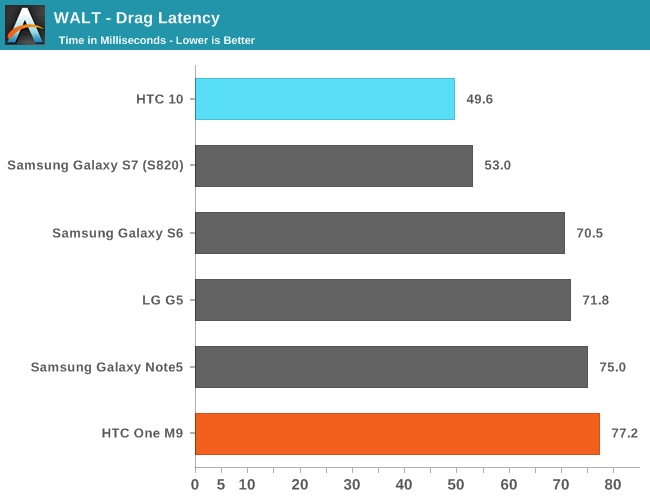
While I would say that WALT's drag latency test seems to be highly unreliable and I'm kind of questionable on whether these results can really be trusted, there's definitely a noticeable difference in how quickly the HTC 10 responds to a swipe compared to most of the competition. The Galaxy S7 seems to keep up which is kind of surprising. I suspect that most of the difference in response between the two devices is the momentum given to a swipe rather than the actual latency.
Misc
With every review there are a lot of little things here and there that I end up discovering along the way that are interesting and worth discussing, but often cannot be discussed in a section of its own, but there are definitely things that have managed to grow past this section into their own as noteworthy.
One of the first places to start is the GNSS of this phone. I’m not sure what exactly HTC did here, but it’s remarkably fast and high quality. When connected to a network A-GPS through the cellular modem (Qualcomm gpsOne) allows for near-instant locks, but I managed to achieve a true cold lock in 1 minute and 6 seconds and it reached a precision of 13 feet within 10 seconds after initial position fix. Precision seems to be as high as 10 feet, which is pretty much the lower bound of what GPS can do without differential GPS systems which allow for precision down to about 10 centimeters.
In addition to GPS reception for whatever reason the HTC 10 seems to have noticeably good reception on AT&T LTE in the SF Bay Area and Los Angeles. It was not unusual for me to see the One M7 sitting on HSPA+ while the HTC 10 would still be on LTE. Of course, I don’t have any formal testing to back this claim up but generally speaking I saw anywhere from 3 to 6 dBm of difference in received power in favor of the HTC 10.
As far as design wins go, ST-M takes the design win for the laser auto-focus sensor, Synaptics is used for the touchscreen, Cypress CapSense Cy8C PSoC is used for the capacitive buttons, an NXP TFA9888 amp is used for the speakers, NXP PN544 is used for NFC, and an Analogix chip is used to enable the USB-C port. It’s identified only by the codename Ohio, but it’s fairly likely that this is the ANX7418. There’s also an ANX7816 for 4K30 over SlimPort. Looking at the SPI bus, for some reason there’s a Micrel KS8851 Ethernet MAC controller and HTC’s custom MCU which is referred to as CwMcuSensor. There’s also an Fingerprints FPC1155 for the fingerprint scanner, and an AK8789 hall sensor.
HTC claims that audio is over a separate DAC and amp, but I really can’t find any evidence that the HTC 10 has a DAC outside of the Snapdragon 820 in the system files, namely the WCD9335. Regardless, the speakers on the HTC 10 are a lot better than most other Android phones on the market. They’re still a step down from the One M9 or M8, but they do provide a fairly convincing stereo effect if you turn it on and overall quality is acceptable. I’m not exactly an audiophile but music over the 3.5mm jack didn’t have any noticeable issues like hissing or popping or anything strange like that.


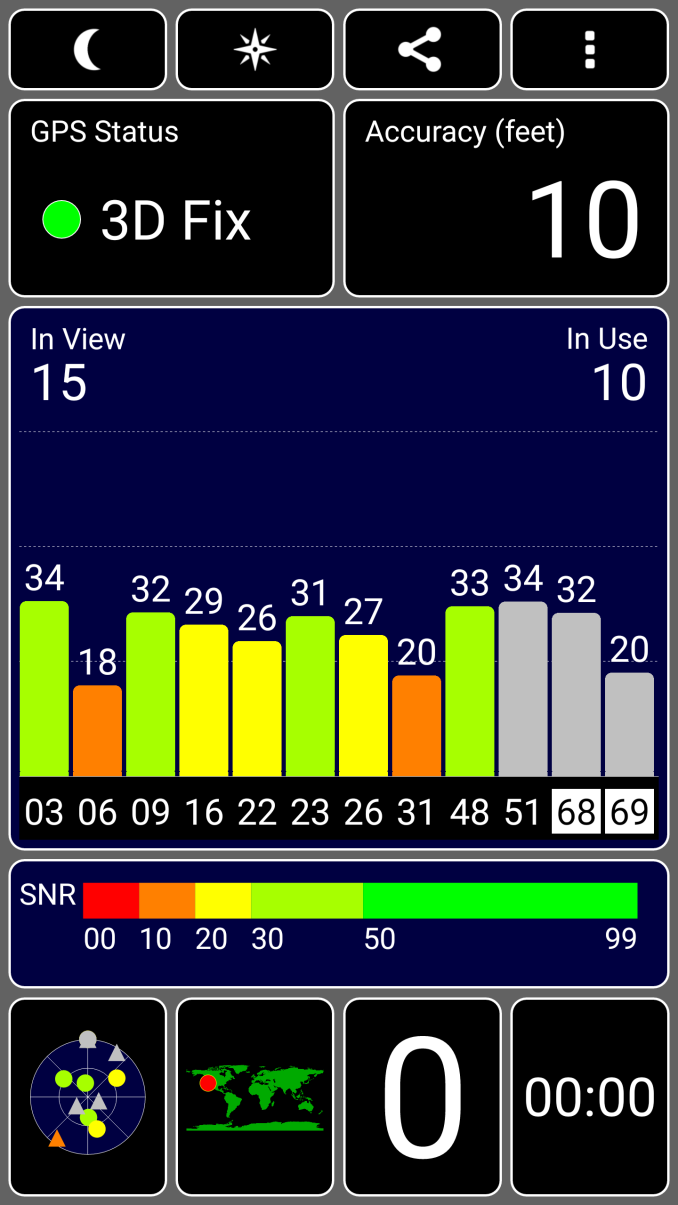








183 Comments
View All Comments
Jigolo - Monday, September 19, 2016 - link
New wifi tests and WALT tests are awesome. Should be in every review they can be in.Dennis Travis - Monday, September 19, 2016 - link
Excellent review Josh. Great Job. Very impressed with the Camera.137ben - Monday, September 19, 2016 - link
TOTALLY UNFAIR! The GNote 7 was reviewed on the day of its release, meanwhile it's been THREE WHOLE DAYS since the iPhone 7 was released and there is STILL NO IPHONE 7 REVIEW! This is blatant favoritism of Android! Everyone knows a review is worthless unless it is posted on the same day the product is released, WHY DOES ANANDTECH HATE APPLE SO MUCH?!?fanofanand - Monday, September 19, 2016 - link
This wasn't even good trolling. Back to the drawing board for you.smorebuds - Monday, September 19, 2016 - link
It sums up a lot of the comments here, though. I mean there are posts with relevant criticism, but they're drowned out by the seemingly obligatory "AT loves Apple more than Android" comments. The iPhone reviews are given the exact same time and priority as Samsung phones, and other devices that have that type of impact on the mobile market.BillBear - Monday, September 19, 2016 - link
This seems so familiar somehow.Nickname++ - Monday, September 19, 2016 - link
Hi Josh, I wouldn't care too much about the absolute RSRP reported by a device. Even in the cellular world the requirement on the absolute accuracy for RSRP are only +/- 6 dB at best (see 3GPP TS 36.133 section 9.1.2.1 for LTE intra frequency measurements for example). And cellular modem have typically stricter calibration and better accuracy than WiFi.So as a general rule, it's best not to rely on devices too much for RF channel absolute quality metrics. The reporting is still interesting, and relative changes are more accurate. But to compare different devices it's pretty much useless IMHO.
Zoomer - Monday, September 19, 2016 - link
Certainly could be an explanation as to why it could maintain better throughput and the connection at lower rssi than the Samsung 820.zer0hour - Monday, September 19, 2016 - link
Yet another months late Anandtech review. Phones, especially flagships, have a yearly refresh schedule. When you post a review 5 months past a product's launch, that's nearly half of the lifecycle.I've been coming to this site for years, but the review cycle these days is getting seriously wonky to the point where the in-depthness of the review is NEARLY not worth it anymore. Have to call it as I see it.
meorah - Monday, September 19, 2016 - link
oneplus 3 owner checking in. price on the HTC 10 is a non-starter. if I'm paying $200 more for a phone and camera is important to me I'm looking towards s7 edge or iphone 7 just for pure cpu/camera performance.HTC is stuck with low brand power, no gimmicks, broken promises, and squeezed by value and performance on both sides.